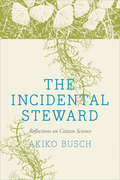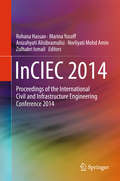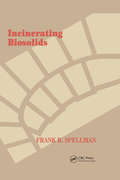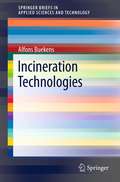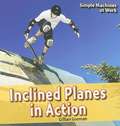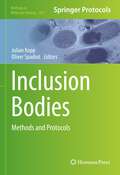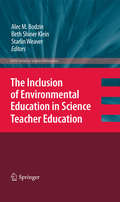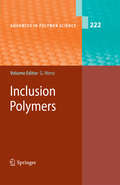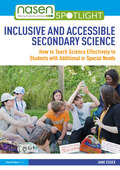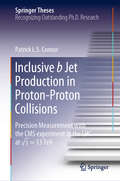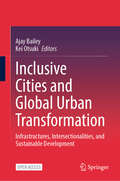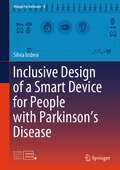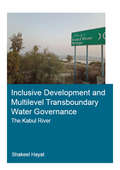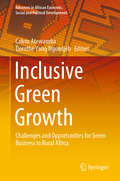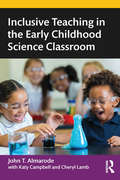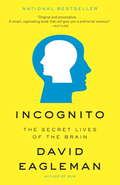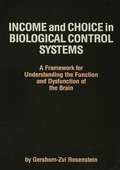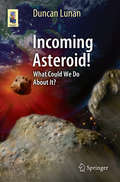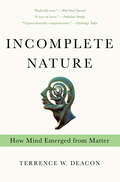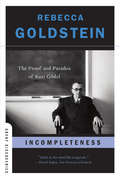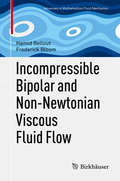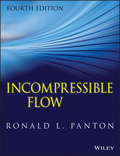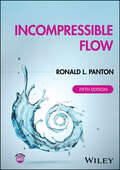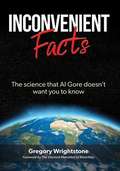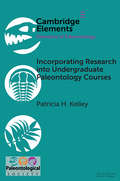- Table View
- List View
The Incidental Steward: Reflections on Citizen Science
by Akiko BuschA search for a radio-tagged Indiana bat roosting in the woods behind her house in New York's Hudson Valley led Akiko Busch to assorted other encounters with the natural world--local ecological monitoring projects, community-organized cleanup efforts, and data-driven citizen science research. Whether it is pulling up water chestnuts in the Hudson River, measuring beds of submerged aquatic vegetation, or searching out vernal pools, all are efforts that illuminate the role of ordinary citizens as stewards of place. In this elegantly written book, Busch highlights factors that distinguish twenty-first-century citizen scientists from traditional amateur naturalists: a greater sense of urgency, helpful new technologies, and the expanded possibilities of crowdsourcing. The observations here look both to precisely recorded data sheets and to the impressionistic marginalia, scribbled asides, and side roads that often attend such unpredictable outings. While not a primer on the prescribed protocols of citizen science, the book combines vivid natural history, a deep sense of place, and reflection about our changing world. Musing on the expanding potential of citizen science, the author celebrates today's renewed volunteerism and the opportunities it offers for regaining a deep sense of connection to place.
InCIEC 2014
by Rohana Hassan Marina Yusoff Anizahyati Alisibramulisi Norliyati Mohd Amin Zulhabri IsmailThe special focus of this proceedings is to cover the areas of infrastructure engineering and sustainability management. The state-of-the art information in infrastructure and sustainable issues in engineering covers earthquake, bioremediation, synergistic management, timber engineering, flood management and intelligent transport systems. It provides precise information with regards to innovative research development in construction materials and structures in addition to a compilation of interdisciplinary finding combining nano-materials and engineering.
Incinerating Biosolids
by Frank R. SpellmanAbout the BookManaging biosolids for reuse and not for disposal is the focus of this book. The emphasis is placed on environmental compliance where the goal is the processing of treated biosolids to the production of a waste product (biosolids ash) that has been discarded in the past and to demonstrate that this particular waste byproduct has some value. When biosolids ash is managed for reuse and is not disposed of in the traditional manner, all sides win, including the environment.
Incineration Technologies
by Alfons BuekensWaste incineration is the art of completely combusting waste, while maintaining or reducing emission levels below current emission standards. Where possible, objectives include the recovering of energy as well as the combustion residues. Successful waste incineration makes it possible to achieve a deep reduction in waste volume, obtain a compact and sterile residue, and eliminate a wide array of pollutants. This book places waste incineration within the wider context of waste management, and demonstrates that, in contrast to landfills and composting, waste incineration can eliminate objectionable and hazardous properties such as flammability and toxicity, result in a significant reduction in volume, and destroy gaseous and liquid waste streams leaving little or no residues beyond those linked to flue gas neutralization and treatment. Moreover, waste incineration sterilizes and destroys putrescible matter, and produces usable heat. Incineration Technologies first appeared as a peer-reviewed contribution to the Encyclopedia of Sustainability Science and Technology. It provides detailed treatment of the challenges of this technically complex process, which requires huge investment and operating costs, as well as good technical skills in maintenance and plant operation. Particular attention is paid to technologies for ensuring the complete burn-out of flue gas and residues and for controlling the resulting pollutants.
Inclined Planes in Action (Simple Machines at Work)
by Gillian GosmanIn this fascinating book, readers will uncover why inclined planes make it easy to lift and move heavy objects. They will also learn where they can find inclined planes in their everyday life and conduct a simple experiment of their own.
Inclusion Bodies: Methods and Protocols (Methods in Molecular Biology #2617)
by Julian Kopp Oliver SpadiutThis detailed volume presents a series of protocols dealing with different aspects of inclusion body (IB) processing, from cloning procedures to purification of refolded product. Commencing with chapters on upstream processing, looking into different expression strategies for IB production, the book continues with downstream applications, highlighting early protein purification and subsequent analytics, as well as success stories of IB-based processes. Written for the highly successful Methods in Molecular Biology series, chapters include introductions to their respective topics, lists of the necessary materials and reagents, step-by-step and readily reproducible laboratory protocols, and tips on troubleshooting and avoiding known pitfalls. Authoritative and practical, Inclusion Bodies: Methods and Protocols serves as an ideal resource for facilitating diverse aspects of IB processing.
The Inclusion of Environmental Education in Science Teacher Education
by Starlin Weaver Beth Shiner Klein Alec BodzinIn the coming decades, the general public will be required ever more often to understand complex environmental issues, evaluate proposed environmental plans, and understand how individual decisions affect the environment at local to global scales. Thus it is of fundamental importance to ensure that higher quality education about these ecological issues raises the environmental literacy of the general public. In order to achieve this, teachers need to be trained as well as classroom practice enhanced. This volume focuses on the integration of environmental education into science teacher education. The book begins by providing readers with foundational knowledge of environmental education as it applies to the discipline of science education. It relates the historical and philosophical underpinnings of EE, as well as current trends in the subject that relate to science teacher education. Later chapters examine the pedagogical practices of environmental education in the context of science teacher education. Case studies of environmental education teaching and learning strategies in science teacher education, and instructional practices in K-12 science classrooms, are included. This book shares knowledge and ideas about environmental education pedagogy and serves as a reliable guide for both science teacher educators and K-12 science educators who wish to insert environmental education into science teacher education. Coverage includes everything from the methods employed in summer camps to the use of podcasting as a pedagogical aid. Studies have shown that schools that do manage to incorporate EE into their teaching programs demonstrate significant growth in student achievement as well as improved student behavior. This text argues that the multidisciplinary nature of environmental education itself requires problem-solving, critical thinking and literacy skills that benefit students' work right across the curriculum.
Inclusion Polymers
by Gerhard WenzThis book contains short and concise reports on physics and chemistry of polymers, each written by the world renowned experts. The book has the highest Impact Factor of all journals ranked by ISI within Polymer Science.
Inclusive and Accessible Secondary Science: How to Teach Science Effectively to Students with Additional or Special Needs (nasen spotlight)
by Jane EssexDrawing on extensive professional experience and detailed empirical evidence, this resource sets out an insightful, highly practical approach to teaching science to secondary-aged students with learning difficulties and other special educational or additional support needs (SEND/ASN). The book explores the barriers that the secondary school science curriculum currently presents to those who do not learn in the expected way, before providing a wealth of practical strategies to help teachers, in both specialist and mainstream settings, to make science more accessible. Multiple science topics are covered in depth, including living and non-living matter, the periodic table, electrical energy, the solar system, the environment and more. Each topic is supported by extensive teachers’ notes outlining activities that will allow educational practitioners to enact the principles of accessibility in the classroom. With rich field notes and practical takeaways included to accompany key insights, this accessible book will provide science teachers at the secondary school level, as well as support staff and anyone aspiring to teach science to SEN/ASN learners, with the guidance and resources they need to make science education meaningfully inclusive.
Inclusive b Jet Production in Proton-Proton Collisions: Precision Measurement with the CMS experiment at the LHC at √ s = 13 TeV (Springer Theses)
by Patrick L.S. Connor^ 74 GeV and |y|
Inclusive Cities and Global Urban Transformation: Infrastructures, Intersectionalities, and Sustainable Development
by Ajay Bailey Kei OtsukiThis open access book addresses the problem of global urban development that excludes various groups of people from the benefits of urban growth and sustainable development. Using the intersectionality and agency of urban dwellers and citizens, it outlines possibilities of responsive urban governance that builds on principles of the inclusive city. The book's first section presents various cases of digital, smart, logistical, and green infrastructure that drive a city's growth and sustainable development while excluding various citizens from these benefits. The second and third sections focus on the intersectionality and agency of urban citizens vulnerable to marginalization in different urban contexts—such as the elderly, people with various physical and mental challenges, women, and children. The last section presents the cases of potential forms of responsive governance and possibilities for future inclusive city planning and development. This book appeals to students of urban and development studies and planning and related disciplines, such as human and cultural geography, applied anthropology, sociology, sustainability sciences, architecture, and design. It is also helpful for activists and practitioners as illustrative cases presented in the book show various experiences and possibilities for making a city inclusive.
Inclusive Design of a Smart Device for People with Parkinson’s Disease (Design For Inclusion #4)
by Silvia ImbesiThis book reports on an inclusive design project aimed at developing IoT-based wearable devices for special populations. Specifically, it covers the design, the implementation and testing of a smart mHealth system that uses sensory cues to monitor and train the gait and posture of people with Parkinson’s disease. It presents a user-centred strategy to better involve the users in defining the most suitable type of sensory cues and their combination, and in the design of the user interface, at the purpose of developing a gait tutoring system that better fits users’ needs and requirements. All in all, this book offers extensive information on the state-of-the-art in the design and testing of innovative user-centred mHealth systems. Giving a particular attention to the explanation of the tools and methodological choices, it provides readers with a timely reference guide to understand and deal with complex inclusive design projects.
Inclusive Development and Multilevel Transboundary Water Governance - The Kabul River (IHE Delft PhD Thesis Series)
by Shakeel HayatThe four decades long ideological-based insurgencies and conflict in the Kabul River Basin (KRB) have seriously hampered the relations and foreign policies of both Afghanistan and Pakistan. Consequently, it restricts them to solve various bilateral issues including transboundary waters. This lack of cooperation over shared water resources is one of the barriers to achieve inclusive and sustainable development. Additionally, it has contributed to the prevailing anarchic situation where each country does what it wants. The absence of a formal water-sharing mechanism coupled with poor water management practices within both the riparian counties are resulting various flow and administration-related challenges. Moreover, these challenges are further exacerbated by regional changes in social, political, environmental and economic systems. The scholarly literature suggests that an analytical transboundary water governance framework is essential to address the challenges of water politicisation and securitisation, quality degradation and quantity reduction. Additionally, the literature rarely integrates (a) a multi-level approach, (b) an institutional approach (c) an inclusive development approach, or (d) accounts for the uses of different types of water and their varied ecosystem services for improved transboundary water governance. To enhance human wellbeing and achieve inclusive and sustainable development in the KRB this research indicates that it is essential to: (1) defrost frozen collaboration; (2) bypass border dispute; (3) use biodiversity and ecosystem services approach; (4) address existing and potential natural and anthropogenic challenges; (5) remove contradictions in the policy environment; (6) combat resource limits and dependence by promoting collaboration on long-term cost effective solutions; and (7) enhance knowledge and dialogue on inclusive development.
Inclusive Green Growth: Challenges and Opportunities for Green Business in Rural Africa (Advances in African Economic, Social and Political Development)
by Calvin Atewamba Dorothé Yong NgondjebFostering inclusive green growth in Africa means addressing existing and emerging development challenges, while efficiently managing Africa’s natural capital and building resilience to environmental, social and economic risks. Although this new paradigm for development has the potential to create tremendous business opportunities, there are also challenges. This book provides empirical evidence on the conditions for the emergence of green businesses in Africa. It includes 13 case studies, which identify the determinants of small and medium-size enterprises’ engagement in inclusive and sustainable growth in rural Africa, and the factors that hinder eco-innovation in business and entrepreneurial activities. Furthermore it discusses appropriate regulations and policies to stimulate the development of green business in Africa. Offering insights into the relationship between eco-innovation, labor productivity and business competitiveness in rural Africa, this book appeals to scholars, policy makers and practitioners interested in a green economy for Africa.
Inclusive Teaching in the Early Childhood Science Classroom
by John T. AlmarodeFocused on engaging all students, Inclusive Teaching in the Early Childhood Science Classroom walks readers through the process of planning, developing, and implementing science instruction for early learners. Drawing on a range of pedagogical processes and approaches, this comprehensive text links science to other disciplines and explores how we develop language, social-emotional, and content learning through early childhood science. Each chapter is framed around an essential question and features success criteria and reflection tasks to guide readers through the content. Aligned with the Next Generation Science Standards and addressing the Interstate New Teacher Assessment and Support Consortium Model Core Teaching Standards, this textbook is critical reading for preservice teacher education students enrolled in an inclusive early childhood or early childhood science methods course.
Incognito: The Secret Lives of the Brain
by David EaglemanIf the conscious mind--the part you consider to be you--is just the tip of the iceberg, what is the rest doing? In this sparkling and provocative new book, the renowned neuroscientist David Eagleman navigates the depths of the subconscious brain to illuminate surprising mysteries: Why can your foot move halfway to the brake pedal before you become consciously aware of danger ahead? Why do you hear your name being mentioned in a conversation that you didn't think you were listening to? What do Ulysses and the credit crunch have in common? Why did Thomas Edison electrocute an elephant in 1916? Why are people whose names begin with J more likely to marry other people whose names begin with J? Why is it so difficult to keep a secret? And how is it possible to get angry at yourself--who, exactly, is mad at whom? Taking in brain damage, plane spotting, dating, drugs, beauty, infidelity, synesthesia, criminal law, artificial intelligence, and visual illusions, Incognito is a thrilling subsurface exploration of the mind and all its contradictions.
Income and Choice in Biological Control Systems: A Framework for Understanding the Function and Dysfunction of the Brain
by Gershom-Zvi RosensteinThis volume introduces the concepts of income and optimal choice to the realms of brain activity and behavior regulation. It begins by developing the concept of the Income-Choice approach in the field of biological control systems, then deals with the problems of control of brain activity, and finally presents a model of behavior disturbance based on the idea that its cause is a definite and simple change in the income system of the organism. Other areas to which the proposed Income-Choice approach could be applied are also addressed including the origin of the epileptic aura and why it is a predictor of the imminent attack, the mechanism of the phenomena of "personality switching" in schizophrenics, and the possible connection between schizophrenic- like symptoms and epileptic status. Written nearly 20 years ago in Russia and now published in the West, this book will be of value to many professionals in related fields. This volume introduces the concepts of income and optimal choice to the realm of brain activity and behavior regulation. It begins by developing the concept of the Income-Choice approach in the field of biological control systems, then deals with the problems of control of brain activity, and finally presents a model of behavior disturbance based on the idea that its cause is a definite and simple change in the income system of the organism. Other areas to which the proposed Income-Choice approach could be applied are also addressed, including the origin of the epileptic aura and why it is a predictor of the would-be attack, the mechanism of the phenomena of "personality switching" in schizophrenics, and the possible connection between schizophrenic- like symptoms and epileptic status. Originally written nearly 20 years ago in Russia and now published for the first time in the West, this book will be of value to many professionals in related fields.
Incoming Asteroid!
by Duncan Lunan'Incoming Asteroid!' is based on a project within ASTRA (the Association in Scotland to Research into Astronautics) to provide scientific answers to the question - what would we do if we knew there was going to be an asteroid impact in ten years' time or less? Clearly there are many things humanity can do nothing about, for example an unseen object traveling towards us so fast that we have no time to prepare, or an object so large it may be unstoppable. A realistic hazard model was decided upon, and the scenario developed from that: an incoming object about 1 kilometer in diameter, in an orbit ranging from the outer rim of the Asteroid Belt to within that of Earth's. Three basic possibilities are considered in this book. The first is the deflection of the asteroid, using remote probes along with a number of possible technologies to change the asteroid's course. Second is the attempt of a manned mission, in order to plant a propulsion system on the asteroid to push it into a different orbit. Third is the nuclear option, a last-ditch attempt to break up and then disperse the asteroid using nuclear weapons. (A rather impractical combination of these second and third options were used as the plot of the popular 1998 Bruce Willis feature film, Armageddon. ) Although the cost of developing the technology needed to protect the Earth would be substantial, there would certainly be spin-off benefits. These could eventually result in practical small-scale atomic energy sources, new propulsion systems that could make extraterrestrial mining within the solar system a possibility, and other as-yet unforeseen benefits. And finally, Incoming Asteroid! considers the political implications - how governments across the world should best react to the threat with a view to minimizing loss of life, and in the weeks running up to the possible impact, preventing panic in the population.
Incomplete Nature: How Mind Emerged from Matter
by Terrence W. DeaconA radical new explanation of how life and consciousness emerge from physics and chemistry. As physicists work toward completing a theory of the universe and biologists unravel the molecular complexity of life, a glaring incompleteness in this scientific vision becomes apparent. The "Theory of Everything" that appears to be emerging includes everything but us: the feelings, meanings, consciousness, and purposes that make us (and many of our animal cousins) what we are. These most immediate and incontrovertible phenomena are left unexplained by the natural sciences because they lack the physical properties--such as mass, momentum, charge, and location--that are assumed to be necessary for something to have physical consequences in the world. This is an unacceptable omission. We need a "theory of everything" that does not leave it absurd that we exist. Incomplete Nature begins by accepting what other theories try to deny: that, although mental contents do indeed lack these material-energetic properties, they are still entirely products of physical processes and have an unprecedented kind of causal power that is unlike anything that physics and chemistry alone have so far explained. Paradoxically, it is the intrinsic incompleteness of these semiotic and teleological phenomena that is the source of their unique form of physical influence in the world. Incomplete Nature meticulously traces the emergence of this special causal capacity from simple thermodynamics to self-organizing dynamics to living and mental dynamics, and it demonstrates how specific absences (or constraints) play the critical causal role in the organization of physical processes that generate these properties. The book's radically challenging conclusion is that we are made of these specific absenses--such stuff as dreams are made on--and that what is not immediately present can be as physically potent as that which is. It offers a figure/background shift that shows how even meanings and values can be understood as legitimate components of the physical world.
Incompleteness: The Proof and Paradox of Kurt Gödel (Great Discoveries)
by Rebecca Goldstein"A gem. . . . An unforgettable account of one of the great moments in the history of human thought." --Steven Pinker Probing the life and work of Kurt Gödel, Incompleteness indelibly portrays the tortured genius whose vision rocked the stability of mathematical reasoning-- and brought him to the edge of madness.
Incompressible Bipolar and Non-Newtonian Viscous Fluid Flow
by Hamid Bellout Frederick BloomThe theory of incompressible multipolar viscous fluids is a non-Newtonian model of fluid flow, which incorporates nonlinear viscosity, as well as higher order velocity gradients, and is based on scientific first principles. The Navier-Stokes model of fluid flow is based on the Stokes hypothesis, which a priori simplifies and restricts the relationship between the stress tensor and the velocity. By relaxing the constraints of the Stokes hypothesis, the mathematical theory of multipolar viscous fluids generalizes the standard Navier-Stokes model. The rigorous theory of multipolar viscous fluids is compatible with all known thermodynamical processes and the principle of material frame indifference; this is in contrast with the formulation of most non-Newtonian fluid flow models which result from ad hoc assumptions about the relation between the stress tensor and the velocity. The higher-order boundary conditions, which must be formulated for multipolar viscous flow problems, are a rigorous consequence of the principle of virtual work; this is in stark contrast to the approach employed by authors who have studied the regularizing effects of adding artificial viscosity, in the form of higher order spatial derivatives, to the Navier-Stokes model. A number of research groups, primarily in the United States, Germany, Eastern Europe, and China, have explored the consequences of multipolar viscous fluid models; these efforts, and those of the authors, which are described in this book, have focused on the solution of problems in the context of specific geometries, on the existence of weak and classical solutions, and on dynamical systems aspects of the theory. This volume will be a valuable resource for mathematicians interested in solutions to systems of nonlinear partial differential equations, as well as to applied mathematicians, fluid dynamicists, and mechanical engineers with an interest in the problems of fluid mechanics.
Incompressible Flow
by Ronald L. PantonThe most teachable book on incompressible flow- now fully revised, updated, and expandedIncompressible Flow, Fourth Edition is the updated and revised edition of Ronald Panton's classic text. It continues a respected tradition of providing the most comprehensive coverage of the subject in an exceptionally clear, unified, and carefully paced introduction to advanced concepts in fluid mechanics. Beginning with basic principles, this Fourth Edition patiently develops the math and physics leading to major theories. Throughout, the book provides a unified presentation of physics, mathematics, and engineering applications, liberally supplemented with helpful exercises and example problems.Revised to reflect students' ready access to mathematical computer programs that have advanced features and are easy to use, Incompressible Flow, Fourth Edition includes:Several more exact solutions of the Navier-Stokes equationsClassic-style Fortran programs for the Hiemenz flow, the Psi-Omega method for entrance flow, and the laminar boundary layer program, all revised into MATLAB®A new discussion of the global vorticity boundary restrictionA revised vorticity dynamics chapter with new examples, including the ring line vortex and the Fraenkel-Norbury vortex solutionsA discussion of the different behaviors that occur in subsonic and supersonic steady flowsAdditional emphasis on composite asymptotic expansionsIncompressible Flow, Fourth Edition is the ideal coursebook for classes in fluid dynamics offered in mechanical, aerospace, and chemical engineering programs.
Incompressible Flow
by Ronald L. PantonIncompressible Flow The latest edition of the classic introduction to fluid dynamics This textbook offers a detailed study of fluid dynamics. Equal emphasis is given to physical concepts, mathematical methods, and illustrative flow patterns. The book begins with a precise and careful formulation of physical concepts followed by derivations of the laws governing the motion of an arbitrary fluid, the Navier-Stokes equations. Throughout, there is an emphasis on scaling variables and dimensional analysis. Incompressible flow is presented as an asymptotic expansion of solutions to the Navier-Stokes equations with low Mach numbers and arbitrary Reynolds numbers. The different physical behaviors of flows with low, medium, and high Reynolds number are thoroughly investigated. Additionally, several special introductory chapters are provided on lubrication theory, flow stability, and turbulence. In the Fifth Edition, a chapter on gas dynamics has been added. Gas dynamics is presented as Navier-Stokes solutions for high Reynolds Number at arbitrary Mach number with a perfect gas as the fluid. The existence of several excellent, and free, compressible flow calculators on the internet has been used in the presentation and the homework. With this chapter the textbook becomes a survey of the entire field of fluid dynamics. Readers of the Fifth Edition of Incompressible Flow will also find: New content treating wind turbines Examples and end-of-chapter problems to reinforce learning MATLAB codes available for download Incompressible Flow is ideal for undergraduate and graduate students in advanced fluid mechanics classes, and for any engineer or researcher studying fluid dynamics or related subjects.
Inconvenient Facts: The science that Al Gore doesn't want you to know
by Gregory WrightstoneWell researched, clearly written, beautifully presented and, above all, fact-packed books such as Inconvenient Facts are absolutely essential to the very survival of democracy, to the restoration of true science, and to the ultimate triumph of objective truth.
Incorporating Research into Undergraduate Paleontology Courses: Or a Tale of 23,276 Mulinia (Elements of Paleontology)
by Patricia H. KelleyResearch-led, research-oriented, and research-based teaching incorporate research into teaching to different degrees. Research-led teaching focuses on content and informs students about current research findings, while research-oriented teaching focuses on techniques and often occurs in research methods courses. In research-based teaching, students participate in research. Through this involvement, they benefit from improved content knowledge, research skills, and life skills, as well as enhanced personal development. Research-embedded courses can make such benefits available to a wide range of students. Best practices in experiential learning and the incorporation of research in teaching include intentionality, planning, authenticity, reflection, training, monitoring, assessment, and acknowledgment. In this book, these principles of best practice are illustrated by courses with embedded student research. Guidelines are presented for how to plan and execute a semester-long course-embedded research project, as well as alternative and shorter-term approaches. Research-based teaching provides challenges for students and faculty, but the benefits for all stakeholders are strong.
